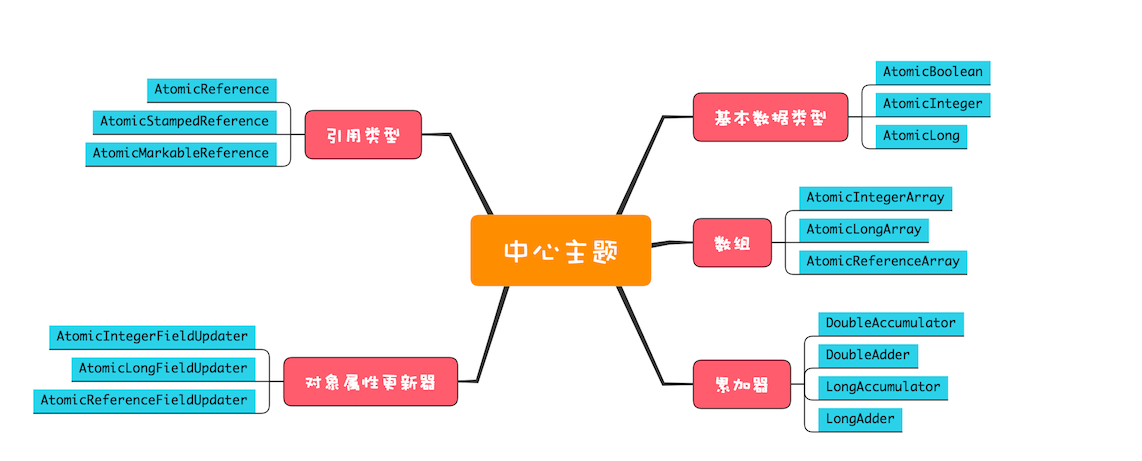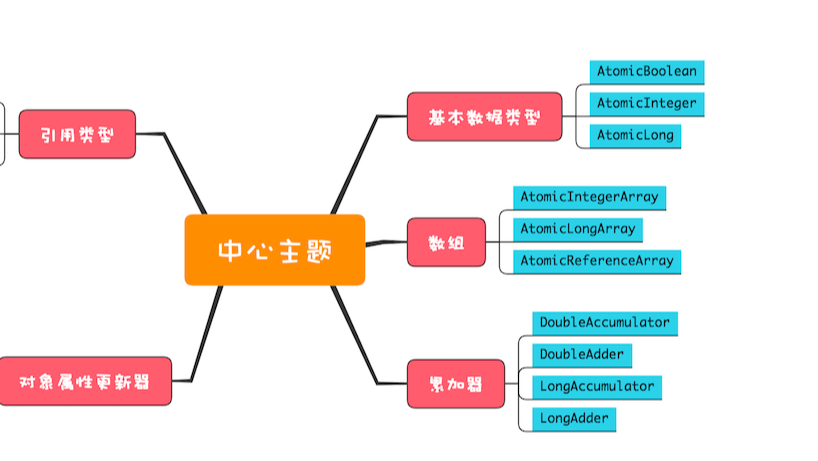Java的Atomic原子类
Java SDK 并发包里提供了丰富的原子类,我们可以将其分为五个类别,这五个类别提供的方法基本上是相似的,并且每个类别都有若干原子类。
- 对基本数据类型的变量值进行原子更新;
- 对对象变量的指向进行原子更新;
- 对数组里面的的元素进行原子更新;
- 原子化的对象属性更新器;
- 原子化的累加器。

基本数据类型
AtomicBoolean、AtomicLong、AtomicInteger 这三个类提供了一些对基本数据类型的变量值进行原子更新的方法。
这些类提供的方法是相似的,主要有(以 AtomicLong 为例):
// 原子化的 i++
long getAndIncrement()
// 原子化的 i--
long getAndDecrement()
// 原子化的 ++i
long incrementAndGet()
// 原子化的 --i
long decrementAndGet()
// 原子化的 i+=delta,返回值为+=前的i值
long getAndAdd(long delta)
// 原子化的 i+=delta,返回值为+=后的i值
long addAndGet(delta)
// CAS操作。如果写回成功返回true,否则返回false
boolean compareAndSet(long expect, long update)
// 以下四个方法新值可以通过传入函数式接口(func函数)来计算
long getAndUpdate(LongUnaryOperator updateFunction)
long updateAndGet(LongUnaryOperator updateFunction)
long getAndAccumulate(long x, LongBinaryOperator accumulatorFunction)
long accumulateAndGet(long x, LongBinaryOperator accumulatorFunction)
// 演示 getAndUpdate() 方法的使用
public static void main(String[] args) {
AtomicLong atomicLong = new AtomicLong(0);
long result = atomicLong.getAndUpdate(new LongUnaryOperator() {
@Override
public long applyAsLong(long operand) {
return operand + 1;
}
});
}
对象引用类型
AtomicReference、AtomicStampedReference、AtomicMarkableReference 这三个类提供了一些对对象变量的指向进行原子更新的方法。如果需要对对象的属性进行原子更像,那么可以使用原子化的对象属性更新器。
public class ClassName {
AtomicReference<Employee> employeeAR = new AtomicReference<>(new Employee("小明"));
public void methodName() {
Employee oldVal = employeeAR.get();
Employee newVal = new Employee(oldVal.getName());
employeeAR.compareAndSet(oldVal, newVal);
}
}
对象引用的原子化更新需要重点关注 ABA 问题。当一个线程在进行 CAS 操作时,另一个线程可能会在此期间修改了同一个共享变量的值,然后又将其改回原来的值。这种情况下,CAS 操作就无法检测到共享变量值的变化,从而导致 ABA 问题。如果我们仅仅在写回数据前判断数值是 A,可能导致不合理的写回操作。AtomicStampedReference 和 AtomicMarkableReference 这两个原子类可以解决 ABA 问题。
- AtomicStampedReference 通过为对象引用建立类似版本号(stamp)的方式,来解决 ABA 问题。AtomicStampedReference 实现的 CAS 方法增加了版本号参数
- AtomicMarkableReference 的实现机制则更简单,将版本号简化成了一个 Boolean 值
boolean compareAndSet(V expectedReference, V newReference,
int expectedStamp, int newStamp)
boolean compareAndSet(V expectedReference, V newReference,
boolean expectedMark, boolean newMark)
数组
AtomicIntegerArray、AtomicLongArray、AtomicReferenceArray 这三个类提供了一些对数组里面的的元素进行原子更新的方法。
public class ClassName {
AtomicLongArray atomicLongArray = new AtomicLongArray(new long[]{0, 1});
public void methodName() {
int index = 0;
long oldVal = atomicLongArray.get(index);
long newVal = oldVal + 1;
atomicLongArray.compareAndSet(index, oldVal, newVal);
}
}
原子化的对象属性更新器
原子化的对象属性更新器有:AtomicIntegerFieldUpdater、AtomicLongFieldUpdater、AtomicReferenceFieldUpdater。
这三个类提供了一些对对象的属性进行原子更新的方法。这些方法是利用反射机制实现的。
public class ClassName {
AtomicIntegerFieldUpdater<Employee> fieldUpdater =
AtomicIntegerFieldUpdater.newUpdater(Employee.class, "salary");
Employee employee = new Employee("小明", 1000);
public void methodName() {
int oldVal = employee.getSalary();
int newVal = oldVal + 1000;
fieldUpdater.compareAndSet(employee, oldVal, newVal);
}
}
需要注意的是:
- 对象属性的类型必须是基本数据类型,不能是基本数据类型对应的包装类。如果对象属性的类型不是基本数据类型,newUpdater() 方法会抛出 IllegalArgumentException 运行时异常。
- 对象的属性必须是 volatile 类型的,只有这样才能保证可见性。如果对象的属性不是 volatile 类型的,newUpdater() 方法会抛出 IllegalArgumentException 运行时异常。
// AtomicIntegerFieldUpdater 类中的代码
if (field.getType() != int.class) {
throw new IllegalArgumentException("Must be integer type");
}
if (!Modifier.isVolatile(modifiers)) {
throw new IllegalArgumentException("Must be volatile type");
}
原子化的累加器
原子化的累加器有:LongAdder、DoubleAdder、LongAccumulator、DoubleAccumulator。这四个类仅仅用来在多线程环境下,执行累加操作。
相比原子化的基本数据类型,原子化的累加器的速度更快,但是它(原子化的累加器)不支持 compareAndSet() 方法。如果仅仅需要累加操作,使用原子化的累加器性能会更好。
原子化的累加器的本质是空间换时间。
LongAdder 的使用示例如下所示:
public static void main(String[] args) {
LongAdder adder = new LongAdder();
// 初始化
adder.add(1);
// 累加
for (int i = 0; i < 100; i++) {
adder.increment();
}
long sum = adder.sum();
}
LongAccumulator 与 LongAdder 类似,但 LongAccumulator 提供了更加灵活的累加操作,可以自定义累加函数。
使用示例如下所示。在使用示例中,我们创建了一个 LongAccumulator 对象,初始值为1,累加函数为 (x, y) -> x * y,即每次累加都将之前的结果与新的值相乘。然后,我们累加了三个数值,最后输出累加结果。由于累加函数是(x, y) -> x * y,所以最终的累加结果为1 * 5 * 10 * 20 = 1000。
public static void main(String[] args) {
LongAccumulator accumulator = new LongAccumulator(new LongBinaryOperator() {
@Override
public long applyAsLong(long left, long right) {
return left * right;
}
}, 1);
// 初始值为1,累加函数为(x, y) -> x * y
accumulator.accumulate(5);
accumulator.accumulate(10);
accumulator.accumulate(20);
// 累加结果为 1 * 5 * 10 * 20 = 1000
long result = accumulator.get();
}
参考资料
本文来自博客园,作者:真正的飞鱼,转载请注明原文链接:https://www.cnblogs.com/feiyu2/p/atomic.html

 Java SDK 并发包里提供了丰富的原子类,我们可以将其分为五个类别,这五个类别提供的方法基本上是相似的,并且每个类别都有若干原子类。
Java SDK 并发包里提供了丰富的原子类,我们可以将其分为五个类别,这五个类别提供的方法基本上是相似的,并且每个类别都有若干原子类。

